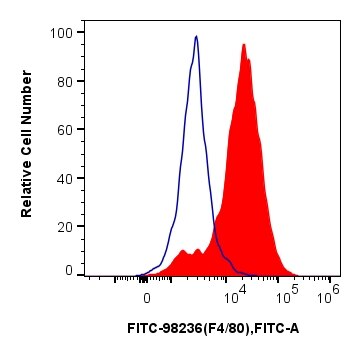Validation Data Gallery
Tested Applications
| Positive FC detected in | mouse peritoneal macrophages |
Recommended dilution
| Application | Dilution |
|---|---|
| This reagent has been tested for flow cytometric analysis. It is recommended that this reagent should be titrated in each testing system to obtain optimal results. | |
| Sample-dependent, Check data in validation data gallery. | |
Product Information
FITC-98236 targets F4/80 in FC applications and shows reactivity with mouse samples.
| Tested Reactivity | mouse |
| Host / Isotype | Rabbit / IgG |
| Class | Recombinant |
| Type | Antibody |
| Immunogen | Recombinant protein 相同性解析による交差性が予測される生物種 |
| Full Name | EGF-like module containing, mucin-like, hormone receptor-like sequence 1 |
| Calculated molecular weight | 102 kDa |
| GenBank accession number | NM_010130.4 |
| Gene Symbol | F4/80 |
| Gene ID (NCBI) | 13733 |
| Conjugate | FITC Plus Fluorescent Dye |
| Excitation/Emission maxima wavelengths | 495 nm / 524 nm |
| Form | Liquid |
| Purification Method | Protein A purification |
| UNIPROT ID | Q61549 |
| Storage Buffer | PBS with 0.09% sodium azide and 0.5% BSA , pH 7.3 |
| Storage Conditions | Store at 2-8°C. Avoid exposure to light. Stable for one year after shipment. |
Background Information
Mouse F4/80, also named as EMR1 and Gpf480, is a 160-kDa cell surface glycoprotein which is a member of the EGF TM7 family. The F4/80 molecule is solely expressed on the surface of macrophages and serves as a marker for mature macrophage tissues, including Kupffer cells in liver, splenic red pulp macrophages, brain microglia, gut lamina propria and Langerhans cells in the skin. The function of F4/80 is unclear, but it is speculated to be involved in macrophage adhesion events, cell migration or as a G protein-coupled signaling component of macrophages.
Protocols
| Product Specific Protocols | |
|---|---|
| FC protocol for FITC Plus F4/80 antibody FITC-98236 | Download protocol |
| Standard Protocols | |
|---|---|
| Click here to view our Standard Protocols |

